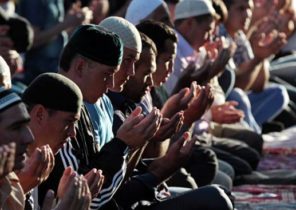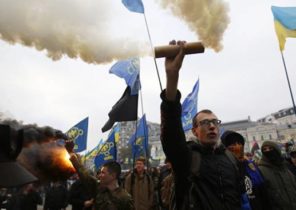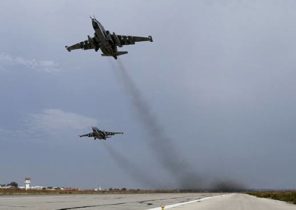Around, as far as the eye stretches a wasteland. Grazing a few cows. On the coast of the former mouth of the Bay rust two huge port crane. Stand the empty port buildings, warehouses, fish factories of the Soviet era.
The sand dust is seen a fragment of a shell — trace of the past days. Just a few decades ago, it was the fourth largest lake in the world, it was noisy busy fishing port.
The town of Aralsk in the North-West of Kazakhstan witnessed one of the largest environmental disasters in world history. In the 1960-ies of the Aral sea, located on the border of Kazakhstan and Uzbekistan, became dry. From the initial lake area of 68 thousand square kilometers in 1990-e years there was only tenth.
The Soviet Union transformed the environment for human needs without worrying about the risks. When in the 1950s, the country decided to increase its production of cotton, the rivers Amu Darya and Syr Darya began to withdraw for irrigation of cotton fields, and most remained in their beds of water evaporate before they reach the Aral sea.
Soviet scientists warned of possible environmental disaster, but nobody listened, finding that the economic benefits will be incomparably greater than the harm to the environment.
The shoreline began to recede. At first the fishermen were chasing her, building the new Marina and the base and away from the city, but in the end gave up.
Soon the coastline was removed in some places to a distance of a hundred kilometers from Aralsk, located on the northeastern shore of the lake. Vital fishing industry died. The world Bank estimates, income in the region has lost a total of 40-60 thousand fishermen.
In place of the lake there are tens of thousands of square kilometers of salty sand with impurities of fertilizers, pesticides and pesticides widely used in cotton fields.
Desert wind carry the sand for thousands of kilometers, but the most poisonous of dust affecting residents of coastal regions.
The impact of environmental disasters is exacerbated by rapid climate change, and social problems of independent Kazakhstan, in particular, the lack of good health.
In the evening on the side of the main street of Aralsk wandering herd of cows. Locals curiously look at the travelers who come from afar. Children with a mixture of embarrassment and interest shout “Hello” and giggle. Above the gray buildings towering minarets with Golden domes, this morning convened the congregation to prayer, the ringing of bells.
On the vacant lot between the houses is visible to a huge pile of garbage, which brings down the stinking black smoke. So here managing waste. Everywhere is the smell of burning coal.
Local feel myself, as the climate changed. In the summer it became unbearably hot: the temperature rises to 45 degrees. In winter there are severe frosts. Often carried by dust storms.
The environmental disaster had devastating consequences for the health of the inhabitants of the region.
In the late 1990-ies, the infant mortality rate in the region was the highest in the world, and the situation is still severe.
In 2015 Kazakh national University in Almaty has published a study that showed that in the blood in children of the Aral sea region includes many toxic substances such as Nickel, chromium, strontium, barium, and uranium.
In the urine of children were found to have DDT, and in the milk of nursing mothers with a high density of extremely dangerous pesticide TCDD, which accumulate in the body, causing cancer.
Adults and children here suffer from anemia, cancer, kidney disease and propagating with the speed of the TB epidemic.
When the locals say how much they are often amazed to look many decades older than his age.
Akimat of Aral region located in the Central square of the city of Aralsk. The young Deputy mayor of Merey Meirbekov sitting in his large, bright office on the second floor.
On the wall hangs a portrait of Nursultan Nazarbayev, who held the post of the President of Kazakhstan since the collapse of the Soviet Union in 1991 and officially retired in March 2019.
Meirbekov chooses his words carefully and answers the questions of the Cribs, which conveys to him an assistant.
“Thanks to our President Nursultan Nazarbayev, in 2000 started a project to restore the Northern Aral sea and the construction of the Kokaral dam which was completed in 2008-2009,” says Meirbekov.
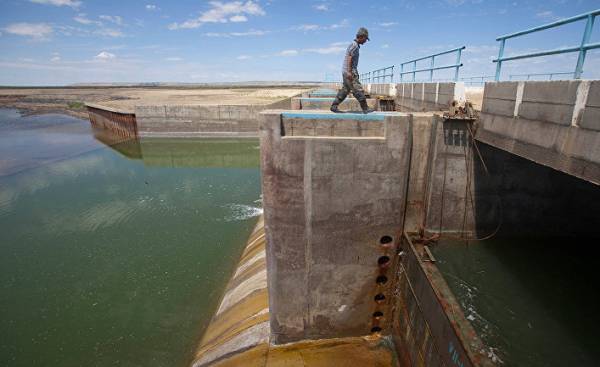 © AP Photo, Sergey PonomarevКокаральская dam in Kazakhstan
© AP Photo, Sergey PonomarevКокаральская dam in Kazakhstan
Built with the support of the world Bank, the dam holds back the waters of the Syr Darya in the Northern part of the lake, and with its appearance the water level in the Northern Aral sea began to grow rapidly.
Prior to this, the level of so-called Small sea has reached no more than 30 meters. Now the depth has increased to 42 meters, and the coastline moved back towards Aralsk 15 kilometers.
“We hope that it will be possible to implement the second phase of construction, and the depth of the lake will increase to 48 meters, and the water border will be held for the kilometer from the town,” says Meirbekov.
Kazakhstan is still negotiating with the world Bank regarding the increase in the height of the Kokaral dam and the financing of the project.
In addition to installing the dam to prevent drying of land by the state planted area of 56 thousand hectares, which was formerly covered with water, shrub trees — saksaul. They prevent erosion and keep the salty sand with poisonous impurities.
Local residents seem to perceive the incident quite calmly. Often slip into the conversation the phrase “back when it was lake” sounds like a statement of fact, not regret about the past. On the contrary, the people here are proud of the history of their city.
Where once was the port in the old merchant’s house is the city Museum of fisheries. One of the walls in the main exhibition hall completely enclosed picture, where the fishermen deftly dragged network in their boats, and the background is visible the Aral port.
Guide Zeinulla Abdiev shows the treasure of the Museum — lathe, Lenin presented fish factory in 1921. The gift was made in gratitude to the fishermen of the Aral sea because they responded to the request of Lenin, and sent 14 wagons of fish to the starving revolutionaries.
The residents of the area already have reason for optimism: the fishing and other industries, gradually come alive.
Pride city guide is the enterprise “Aral LMS”, which started in 2010 and received the title of best startup. The company exports fish products to Russia, China, Poland, Ukraine and other countries.
The largest employer of Aralsk was founded in 1925 “Araltuz” — old, clearly knew the best days of the plant outside the city. The company, which employs 1,200 people, is engaged in mining and refining salt from a nearby salt lake, including for the Russian market.
To obtain specific information about declined with the advent of the dam a number of diseases, very difficult. For example, according to the study of the group of Kazakh scientists published in 2016, cancers still occur more frequently than in other regions of Kazakhstan.
In addition, it is reported that local residents are more greatly prone to respiratory diseases.
About the revival of the economy can be judged by the new residential areas are sprouting up on the outskirts of the city. Today, the Aral population of about 35 thousand people, which is 5 thousand more than ten years ago. The population of the Aral area is about 79 thousand people.
Aralsk definitely can not be called a popular tourist place. The only local attraction – the skeletons of fishing boats left to rust decades ago on the shore of the extinct lake.
To see them, it is better to hire an experienced guide who has a SUV.
Everywhere outside of Aralsk the same landscape — a mountainous area covered with grass and low shrubs. On the vast wasteland grazing herds of horses and herds of camels and circling in the sky eagles and falcons.
No catches no Internet, no phone. The presence of the person here are the only roads that really are just traces of tyre tracks in the sand.
Earlier the Kazakh side of the Aral sea was hundreds of abandoned ships, but in recent years their number has decreased significantly. Locals say that there were only six. All the others without permission cut up and sold to buyers of steel.
Nearly half of the Aral sea located on the territory of Uzbekistan. There’s old ships were no more, and the Kazakh tourist business curses sluggish stance of the authorities on the preservation of objects that could attract tourists.
The remains of the ships lie on the shoreline in the Gulf of Butakov in the North Aral sea, it returned almost to its original place.
Ships, shines the mirror of a vast Aral sea now looks more like a sea than a lake. Looking at it, it is hard to understand the scale of the disaster.
Nevertheless, a great space closer to the city, where camels now graze, used to be covered with water. The breathtakingly beautiful cliffs before washed, foaming waves of the Aral sea.
On the coast of the Butakov Bay nestles the fishing village of Akespe — abandoned like ships.
There still are a few people, and the wind is slowly catching up here in the sand, forming a slowly moving dunes, resembling the Sands of the Sahara.
In the 1990-ies, when the shallowing of the lake has reached its climax, the work in the village did not. With the collapse of the Soviet Union in 1991 stopped working utilities, and living here has become impossible.
Some residents left, and the remaining tried to replace fishing with something else, for example, breeding of camels and horses.
With the advent of the Kokaral dam in the history of the village there was a happy twist.
About a kilometer from the old Akespe, a little farther from the shore of the lake returned, there, where you do not get the strongest sandstorm is a new Akespe with a population of about two hundred people.
Almost all the houses here, in Kazakh sturdy and neat, was built after the appearance of the dam.
In the village there is a clinic where you can get primary care. In emergency cases the ambulance comes from Aral hospital.
It seems that lost among the wasteland the village is located on the edge of the world, but thanks to social networks, the people here maintain contact with the world.
Eleven-year-old schoolgirl Shapagat Karibaeva, who dreams of becoming a fashion designer, says that actively use Instagram. It is signed on the pages of various clothing brands and beauty.
The girl’s preppy school uniform. Now the school break, and she goes along with classmate aliyah Chaseway home for lunch. Aliya, when will grow, wants to become a journalist.
The fathers of both girls are engaged in fishing. At Shapagat mother is a housewife, and alia — the teaching in the school.
Girls like to live in Akespe, but they are unlikely to remain.
“When I grow up, I want to move to the capital, Nur-Sultan”, — shares his plans Karibaeva.
Some young people, for example, 22-year-old Zarima Karasawa and her 27-year-old husband Altenbeck Karasov chose to stay. They live in Akespe with Yingli year-old daughter and two year old son Nurbek.
Now the family builds a new house alongside the old.
“The building will probably be ready next year. I have to do everything myself: from building boom to find a job is not easy,” says Altenbach.
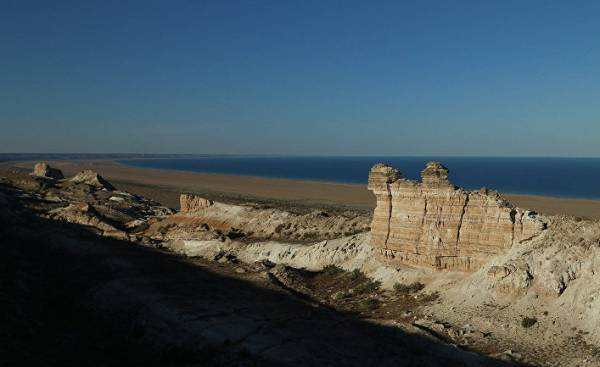 © AFP 2020, Sebastien BERGERАральское sea in Uzbekistan
© AFP 2020, Sebastien BERGERАральское sea in Uzbekistan
Half of the income Karasov produces, like his father, fishing, and the rest of the time he works in an oil company outside of Akespe.
Sarima Karasova — a primary school teacher, but now in the rural schools do not have enough children of primary school age, to gain class, so she stays home with the children and as undermining takes tourists in Akespe to look at abandoned vehicles.
Near the entrance is a simple plate on which Sarima cook. According to Asian traditions, eat here in the living room at a low table, taking seats on the soft carpet on the floor.
In the middle of the meal in the house gets a neighbor Karasevich drunk. He is willing to talk and wants to join the company, but Karasova gently pushes him towards the exit.
Altenbeck brings a long list of fish, which now again you can catch in the Aral sea: perch, catfish, pike, carp, Chub…
The fish he sells to local enterprise, which freezes it and takes the fish factory in Aralsk. From there it goes to the domestic market and for export to Russia, Poland and Israel.
Young people are optimistic: “prices of fish are rising, demand also.”
About 60 kilometers from Aralsk on the shores of lake Kamystybas in the village COSJAR is a fish hatchery, which also contributed to the revival of the Small sea.
“The nursery was established in 1966 when the lake began to dry up. In the end into a shallow pond of all fish species is preserved only flounder”, says its Director Nurkamal Onagers.
The lack of water along with evaporation resulted in the fact that the salt content in the Aral sea has increased dramatically, and for fish it was disastrous.
“The nursery was established to preserve the genetic resource of fish disappearing lake. Other lake take, we give,” proudly States Onagers.
The farm is located on the balance of the state. There are dozens of ponds. Because the court of autumn, winter the ponds were still unoccupied, during the summer the carp swim. When they are old enough, they will be released into the Aral sea.
According to Kulanova, in the Small sea is now usual for 25 species of fish, nearly the same as it was before the drying of the lake. Haven’t managed to return only a capricious sturgeon.
Kazakhs can rejoice in the recovery of the North Aral sea, but in the southern part of the lake the situation is different.
On the other side of the border, in Uzbekistan, there is an outflow of the population, remains difficult situation in the social sphere and in health care.
For Uzbekistan, cotton production is much more important than for Kazakhstan. The country is trying to switch from cotton to growing crops that would not require such a significant irrigation, but this is a difficult task and change happens slowly.
Thus, according to the UN, the use of forced and child labor on cotton plantations still declined.
The government is taking various measures to combat environmental disaster: here restore lakes and wetlands, collect the spilled water from the Amu Darya into the artificial lake, the area of half a million hectares was planted with saxaul.
Natalia Barteneva, Professor of biology of the Kazakh Nazarbayev University, which his research group has been studying the Aral sea, notes that the southern part of the hope is almost there.
“Although in the Northern part of the lake ecosystem restored in the South the salt concentration continues to increase, and the shoaling continues. The remaining Large sea, apparently, will continue to dry and will soon disintegrate into two halves,” — says Bartenev.
“The restored part is only five percent of the original area of the lake”.
The Aral sea has friends in misfortune. Bartenev recalls that the activities of the person in distress can find, for example, the Great Salt lake in Utah and lake Urmia in Northwest Iran.
For Aralsk return and five percent of the lake is a big deal.
Deputy akim of the Aral region of Meirbekov sure that the situation will improve when the Kokaral dam will be higher.
The world Bank representative said that the details of the agreement it is planned to agree by the end of 2020.
Meirbekov hope for the best: “most of all I dream about, back in town with waves and ships.”



